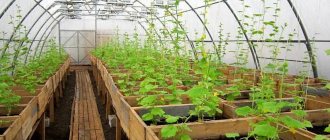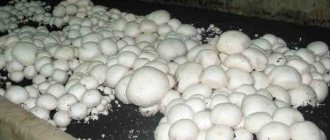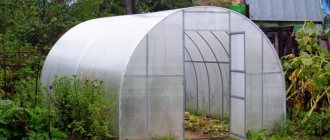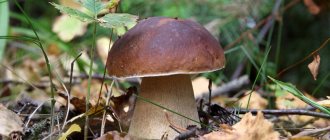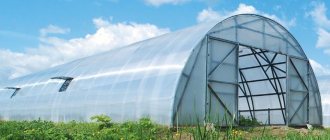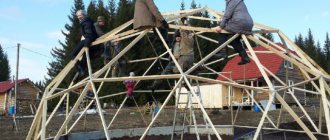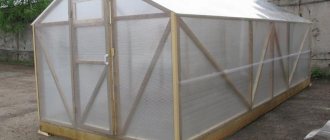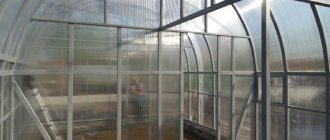Active deforestation leads to the fact that wild mushrooms have become a very expensive delicacy. On the other hand, rising prices and constant demand have led to intensive cultivation of mushrooms in artificial conditions. In order to grow a delicious product, you will need a greenhouse for growing mushrooms. Recommendations for its arrangement are given in this article. Now many gardeners have begun to grow mushrooms in their garden plots. Despite the cost of this type of activity, it is still quite profitable, because even from a small plot, abundant harvests are collected all year round.
Greenhouse requirements
You can grow mushrooms in a greenhouse made of any material - polycarbonate, film or glass. However, it must meet the following requirements:
- Have a heating system . It is better to give preference to a water system, since it does not dry out the air as much as other heating methods. As a rule, thanks to this installation, the air in the greenhouse is always fresh, which is important for the growth of mushrooms.
- Assume high-quality sealing and insulation . Without them, it will not be possible to maintain a stable microclimate in the room, as well as optimal levels of temperature and humidity.
- Have a ventilation system or supply and exhaust ventilation . It provides the mushrooms with the fresh air they need for rapid and proper development.
- Have an irrigation system . The mycelium needs regular watering, so it is important to ensure easy access to water. The method of spraying it is considered optimal. If the greenhouse is small, all manipulations can be done manually, but if it is large, then it is better to take care of a special spray system.
- Assume protection from direct sunlight . For these purposes, the roof of the structure can be covered with curtains made of a less transparent (matte) film or whitewashed with lime.
- Have the right equipment . A greenhouse for growing mushrooms also needs to be equipped with shelving or tables for placing containers. For the same purposes, you can use special racks on which blocks or containers are suspended.
Residential basements should not be equipped for growing mushrooms, since excessive dampness will lead to the destruction of the foundation and the collapse of the building.
The benefits of greenhouse mushrooms
Mushrooms are a separate biological kingdom. This product has a number of useful qualities. It contains balanced proteins, fats, carbohydrates, vitamins and microelements. The product is popularly called “dietary forest meat.” It is worth noting that it is not suitable for baby food, as it is poorly digestible. Adults also do not need to abuse such food. Moderate consumption of mushroom dishes will have a positive effect on the condition of the body.
- Mushrooms contain a large amount of protein. Therefore, they can be considered an alternative to meat. Used by vegetarians to replenish protein in the body. Suitable for use during fasting.
- Low calorie content. 100 g of buttermilk contains only 9 kcal, honey mushrooms - 17, milk mushrooms - 16, white mushrooms - 22, champignons - 27. In dry form, the calorie content increases. Mushrooms are great for those who are on a diet or watching their figure.
- The content of B vitamins helps maintain the functioning of the nervous system and has a positive effect on the condition of the skin, nails and hair.
- Anti-cellulite effect. Possessing a high potassium content, mushrooms are able to remove excess fluid from the body, thereby preventing the development of cellulite.
- Microelements contained in mushrooms normalize metabolism and can protect the body from viral infections.
Mushrooms contain a lot of useful vitamins and microelements
Growing mushrooms in a greenhouse has a lot of positive aspects. This is an opportunity to diversify your site and gain new knowledge. The harvest obtained in greenhouses is completely natural and does not contain toxins. Chemical fertilizers are not required for growing mushrooms. And the whole process can be turned into a profitable business.
Greenhouse organization
It is customary to grow mushrooms in cold weather - from October to April, so often for this purpose they use an ordinary greenhouse made of film, which has already been freed from vegetables. Meanwhile, in order to convert a conventional polycarbonate greenhouse for growing mushrooms, a number of changes will need to be made to the design. In the future, the converted greenhouse can also be used for growing seedlings and vegetables.
Sealing and insulation
If the greenhouse structure is installed efficiently, then it does not have gaps through which heat escapes. In this case, sealing will not be required. If the installation work was carried out incorrectly or, as a result of careless operation, damage, cracks and gaps formed in the shelter itself or between it and the frame, then the greenhouse will need to be sealed. To do this you need to do the following:
- Identify any damage to the film or polycarbonate and carefully seal it with tape.
- If there are gaps between the frame and the base, they need to be sealed using a high-quality sealant.
- Seal the door and windows with a rubber seal and additionally install locks.
- Cover the ground with foamed polyethylene with a metallized layer to provide thermal insulation from the cold soil.
To save money on heating, it is recommended to additionally insulate the interior of the greenhouse by making a second contour of the shelter:
- Place arcs made of PVC pipes or fiberglass reinforcement inside the greenhouse. Their height should be sufficient to place shelves with mushrooms in the greenhouse and allow the farmer to move freely.
- Pull a thick covering material over the installed materials.
It should be noted that the double shelter of a greenhouse has many advantages:
- improves thermal insulation;
- reduces exposure of mushrooms to direct sunlight and protects against additional burns;
- helps maintain a more even and stable microclimate, even in the event of sudden changes in temperature outside the greenhouse.
A greenhouse with double cover looks like this:
For additional insulation, you can also attach a polycarbonate frame to the inside of the greenhouse. The resulting air gap between the outer and inner sheets will provide excellent thermal insulation.
To protect mushrooms from sunburn, it is recommended to use colored or translucent polycarbonate.
Curtaining
If the greenhouse is insulated using colored polycarbonate or agrofibre, there is no need to curtain it, since these materials do an excellent job of dispersing sunlight and reducing illumination. Otherwise, curtaining is required, which can be done in two ways:
- install curtains made of thick fabric under the roof of the greenhouse;
- whitewash the structure with lime mortar.
Experienced farmers recommend choosing the second method, since whitewashing with lime not only helps protect mushrooms from solar radiation, but also perfectly disinfects the walls of the structure.
Ventilation
Mushrooms constantly need an influx of fresh air, especially during the period of active growth, so the greenhouse must be equipped with a ventilation system. It can be organized this way:
- Make a standard window above the doors or in the roof of the greenhouse. It is not advisable to make windows on the walls, since in this case a draft will pass through the mycelium itself.
- Install ventilation equipment, since it is not possible to keep the window open in any weather. In addition, access to it may be difficult if a double shelter is used. So, in the greenhouse you need to install pipes for supply and exhaust ventilation, passing them through the roof or end wall.
In order for the supply and exhaust ventilation to work in natural mode, that is, according to the laws of air exchange and without ventilation, the bottom of the supply pipe should be located at a height of 15-30 cm from the floor. This way the exhaust pipe will draw warm air from the ceiling.
- Equip a fan, since difficult air outflow and inflow cannot be ruled out. It should also be taken into account that some types of mushrooms (for example, oyster mushrooms) during certain periods of growth require a very high volume of incoming air, which is almost impossible to provide without a forced ventilation system.
Natural ventilation of the greenhouse can be organized as follows:
Water supply
To water the substrate and maintain the required level of humidity, you need to organize a fine spray of water in the mushroom picker. For maximum cleaning, you should also install a filter. This is a mandatory condition if water is supplied from the sewer.
When choosing an irrigation system, you need to proceed from the size of the room:
- If the greenhouse is small, you can get by with hand sprayers. To do this, it is enough to water the crop using a hand sprayer. In addition, when watering by hand, experts recommend placing tanks of water directly under the mycelium in order to maintain its reserves and a suitable temperature, as well as increase the level of humidity in the mycelium.
- If the greenhouse is large or there is no desire to waste time on watering, you should install a full-fledged air humidification system, which will also water automatically. To water the mycelium with soft and melt water, it is necessary to install a system of tubes connected to a pump into the soil. For large farms, you can install a tube that automatically moves along the guides and creates the pressure necessary to evenly spray water onto the racks with mushrooms. Thus, the humidity of the air and the substrate is simultaneously maintained.
The best indicators of acidity (pH) and hardness (dGH) have melt, rain or river water, which should be used for spraying the substrate and mycelium.
Heating system
To maintain the optimal temperature for mushrooms in the greenhouse in winter, it is necessary to install a heating system. It is easier to do this by connecting the greenhouse to the water heating of the house through a balancing valve, with the help of which it is easy to regulate the temperature in the desired range.
If it is not possible to connect to water heating at home, you will have to install an independent heating device. In this case, the best option is an electric boiler, which is equipped with an automation and safety system. If the size of the greenhouse is small, you can choose a device of low power and affordable cost. It has the following advantages:
- allows you to easily adjust the temperature as the mushrooms develop;
- maintains the set air temperature automatically;
- requires little space;
- easy to install and connect in accordance with the attached diagram;
- does not require installation of a chimney.
The heating circuit with an electric boiler looks like this:
It should be noted that modern boiler models are equipped with a built-in expansion tank and circulation pump, which ensures safe operation and uniform heating of the entire greenhouse.
As for the disadvantages of electric boilers, we can only highlight the high costs of electricity. To minimize them, you will need to properly insulate and seal the room, leaving no cracks or gaps. In this case, the costs will be moderate, especially considering that the mushrooms do not require too high an air temperature.
Radiators or registers made of large-diameter pipes, which are placed around the perimeter of the room at a low height, are also suitable as heating devices.
To reduce heating costs, radiators and temperature sensors should be located inside the additional shelter.
Lighting
This factor mainly depends on the variety of mushrooms. For example, oyster mushrooms do not require any lighting, so you can get by with placing lamps in the greenhouse for your own convenience. If you plan to grow champignons and some other types of mushrooms, this issue will need to be given due attention.
In the second case, it is better to place fluorescent lamps with a power of 100-180 lux/h in the greenhouse. At the same time, lamps that are marked DRL and DRLF are of higher quality, since they emit a red-blue spectrum that is ideal for mushrooms. Such rays are invisible to the human eye, but plants are especially sensitive to them.
The selected lamps must be evenly distributed throughout the greenhouse, and it is advisable to hang them on the ceiling. If this is not possible, lighting fixtures can be placed on the walls.
It is necessary to use additional lighting on cloudy days and during the ripening period of mushroom caps.
Champignon harvest
Approximately 30-40 days after sowing the mycelium, the temperature is reduced to 14-18 degrees. This gives the mushrooms a signal that they need to move to a new place. To move, they throw away the caps that contain pores.
You need to pick mushrooms by carefully twisting them by the stem with your hands. This way the mycelium will not be damaged. If you cut off the cap with a knife, the rest of the stem will rot.
Important! You need to collect all the mushrooms at once, not leaving even small ones. This will stimulate the mycelium to throw out new caps. Thus, within a week it will be possible to harvest a new crop of mushrooms.
From just one mycelium it is possible to collect 8-10 waves or harvests of mushrooms. After this, the mycelium fizzles out and the substrate is depleted. All that remains is to replace the mycelium with the substrate and repeat the cycle again.
If you need to grow mushrooms constantly, it is better to equip two rooms in which the required temperature conditions will be maintained according to each stage of mushroom development.
Despite the fact that the growing process does not require much effort and attention, it becomes extremely exciting. This opens the door to a new and different kingdom - the mysterious kingdom of fungi, which occupy an intermediate position between plants and animals.
What kind of shelving should I put in the greenhouse?
In the greenhouse you need to install shelving or racks, depending on the technology for growing mycelium and the type of mushrooms. Furniture can be made of wood or metal, but the second option is preferable. The fact is that metal structures are easy to process and disinfect, and also do not rot in high humidity conditions. In addition, racks can be easily made from leftover metal, for example, using scraps of reinforcing bar.
Some types of fungi can settle on wood, causing its rapid destruction, so it is likely that wooden shelving will have a short service life.
The design of the rack should be chosen depending on the method of growing mushrooms. So, if you plan to grow them on pallets, you should place racks with several wide shelves in the greenhouse. For more convenient operation, they can be installed at a slight slope.
If you plan to grow mushrooms in briquettes with a substrate, it is better to place narrower shelves or racks in the greenhouse from which the briquettes can be hung. It should be noted that some people prefer to place them directly on the greenhouse floor.
Racks for hanging bags with substrate
Arrangement and preparation of the greenhouse
The next important stage is preparing the greenhouse. Having decided on the type of mushrooms you want to grow, you need to create certain conditions.
- First, purchase mycelium. It is the most accessible biomaterial for growing mushrooms.
- Then make compost. It will be individual for each variety. As a rule, compost is prepared from dry weeds or straw, superphosphate, as well as manure and urea.
- After 4-5 days, add gypsum and water to the prepared mixture. Let the mixture sit for some time, stirring occasionally.
- When the compost reaches the desired condition, feel free to plant mycelium in it.
Preparing mushroom compost in boxes
How to make a greenhouse for growing mushrooms all year round?
To harvest mushrooms all year round, it is advisable to install a special greenhouse in which there is practically no natural light, and a high level of thermal insulation is ensured by digging into the ground and filling the roof with a biodegradable layer, for example, manure.
Meanwhile, the types of structures may differ depending on what materials are used to build the greenhouse - wood, film or polycarbonate. Let's look at all three options in more detail.
Wooden structures
Greenhouses made of wood are suitable for growing different types of mushrooms. They can be assembled from elements such as:
- wooden walls (board or frame);
- compacted clay floor;
- garden bed;
- racks;
- roof;
- thermal insulation layer made of manure;
- choke with valve.
It should be noted that the wooden structure itself can be assembled according to various schemes. The following greenhouses are popular:
- Two-tier 4-flange . It is buried 500-600 mm into the ground, insulated with a mixture of manure and clay. The length of such a structure can be from 25 to 30 m. On average, it occupies an area of 200-230 square meters. m. Heating in such a greenhouse can be provided by electric, gas or stove. Inside the greenhouse, there is little or no natural light. What this design looks like can be seen in the diagram (Fig. A).
- Grachevskaya 7-flange model 1861 . The design according to Grachev is recognized as the most convenient for cultivating mycelium. Its length can be 4, 8, 15 or 25.2 m, and its area can be 100, 200 or 300 sq. m. m. This greenhouse is similar to a two-tier 4-flange design, but is slightly modernized to accelerate the growth of mushrooms. You can see how it looks in the diagram (Fig. B).
- Combined two-tier 4-flange . Its length is 20 m, and its working area is 123 sq. m. m. Such a greenhouse differs from the usual 4-flange design only in size and internal configuration, as can be seen in the following diagram (Fig. B).
1 – wooden wall; 2 – flank or bed; 3 – compacted clay floor; 4 – wooden stand with crossbars; 5 – gable wooden roof; 6 – thermal protection in the form of a layer of horse manure, which is covered with snow in winter; 7 – vent or choke in the form of a wooden box with a felt-lined valve.
Interestingly, Moscow gardeners often use combined 4-flank greenhouses with heating to grow mushrooms from September to February. When their rotation is complete, they use the greenhouse to grow early vegetables, having first replaced the wooden roof with greenhouse frames.
Film greenhouse
The basis of this design is a metal or wooden frame, which is hermetically sealed with a thick film. This option is perfect for year-round cultivation of wild mushrooms.
To provide the greenhouse with the proper level of thermal insulation and prevent excessive sunlight from reaching its walls, it is recommended to make the structure double - with an air pocket and an empty sealed space.
Polycarbonate greenhouse
Like the previous design, this greenhouse consists of a metal or wooden frame, but it is covered not with film, but with sheets of translucent polycarbonate. The frame can be rectangular or made in the form of half a cylinder. To grow mushrooms in such a greenhouse for 12 months in a row, it should also be built with a double wall and an air gap.
Varieties for mushroom growing in greenhouse conditions
The most popular varieties of mushrooms that are cultivated at home are champignons and oyster mushrooms. The latter are distinguished by their unpretentiousness and rapid germination. It is noteworthy that mushrooms, like many vegetables, are grown year-round. But only in winter their cost increases noticeably. A question that will be of interest to many is what other mushrooms can be grown in a greenhouse?
So, such mushrooms include ring mushrooms, honey mushrooms and some forest varieties. Boletus, boletus and white boletus also took root in greenhouse conditions. Another variety of mushroom that is gaining popularity among Russians is shiitake. To grow them, you will need to purchase mycelium in eastern countries.
Shiitake in greenhouse conditions
The nuances of growing champignons
The main feature of growing champignons is a carefully prepared compost mixture. These mushrooms prefer a combination of horse manure and straw. You can choose any droppings (poultry, cattle, etc.) as fertilizer. The compost preparation process is as follows:
- Take straw or other weeds and dry them.
- Then sprinkle with water.
- After the grass has been lying around for about 2 weeks, it must be mixed with a sufficient amount of manure, as well as bulk gypsum and urea.
- Place the resulting mixture in boxes. There it should lie for about 4 days.
- Don't forget to add more manure and achieve the right temperature. Ideally, it should be in the range from 28 to 30 degrees.
- After this, you can begin planting the mycelium in a separate box or pot with compost. Over time, it will grow to impressive proportions.
- After 2–3 weeks, the first mushroom shoots will appear.
- From this moment on, mushrooms should be stored in a cool place, first sprinkled with peat. The temperature should correspond to 15 degrees.
Abundant harvest of champignons
Champignons are collected selectively. This is due to the fact that they grow unevenly. After 2 weeks from the moment of sprinkling with the peat mixture, the first harvest should appear. The fruiting period lasts on average about 1.5 months. During this harvest period, it is very important to maintain optimal temperature conditions and humidity levels. It is necessary to ventilate the room periodically.
Advice. Harvest mushrooms before they are fully ripe. It is not difficult to determine the stage: the film cover is not open on the underside of the cap.
You need to cut the champignons carefully, without damaging the rudiments nearby. After harvesting, the recesses should be covered with damp soil.
Rules for breeding oyster mushrooms
Oyster mushrooms are considered even less demanding than champignons. They do not need to create and maintain the necessary microclimate.
Oyster mushrooms are usually grown in hanging bags filled with mycelium, sawdust and peat. Everything is sprinkled with earth on top.
At the initial stage, oyster mushrooms require a temperature range of 20–25 degrees, later it must be reduced to +8 degrees. Humidity should be at least 90%. It is in such conditions that oyster mushrooms grow better.
How comfortable this variety is in a greenhouse can be determined by its appearance. Thus, fruits with long stems indicate insufficient ventilation. And fleshy and large specimens indicate a low temperature in the greenhouse.
Oyster mushrooms are collected in 3–4 waves with a frequency of 30–50 days.
Growing oyster mushrooms for sale is profitable
Growing porcini mushrooms
Porcini mushrooms are not only a forest delicacy, but also a healthy variety. Finding such a specimen in the forest is quite problematic, but growing it on your own plot with a greenhouse will not be difficult. True, its requirements differ from those of oyster mushrooms and champignons. The main needs of this type include:
- the presence of thunderstorms, foggy and warm nights;
- lack of abundant watering;
- drained dry soils;
- open sunny areas in the country.
Attention! Porcini mushrooms cannot grow on peat, loam, swamp or sandy soil.
Compliance with all the nuances of growing porcini mushrooms in a greenhouse will help make production more efficient.
To grow porcini mushrooms you will need a special substrate. Its composition depends on the method you decide to use to propagate the mycelium. So, if a forest specimen is used as planting material, then along with it it is necessary to take the soil in which it grew.
The use of garden soil is also acceptable. In this case, it should be mixed with sawdust and manure. Let the mixture stand for a week and put it in boxes.
Porcini mushrooms are propagated in two ways:
- disputes;
- mycelium.
The first option uses biomaterial from the forest, and the second uses a ready-made purchased mixture.
Wild mushrooms thrive in greenhouse conditions
Useful tips
To build a greenhouse and safely grow mushrooms in it, you should take into account a number of recommendations from experts:
- For the structural frame, the best material is aluminum, as it is lightweight and wear-resistant. In addition, such material is not afraid of corrosion, and mold will not form on it even in conditions of high humidity. For the same reasons, it is worth installing shelving and racks made of aluminum in the mycelium.
- In order to improve thermal insulation, the floor should be covered with foamed polyethylene or other material that has similar properties. In addition, it is necessary to pay due attention to sealing the greenhouse, since any cracks and holes in the shelter lead to a decrease in the heat level, and therefore to an increase in heating costs.
- The greenhouse in which it is planned to grow mushrooms cannot have a translucent or transparent roof. It needs to be built or converted in such a way that the incoming light is dim. To do this, you can use several tricks: paint the translucent ceiling with chalk;
- tint the roof and walls with special adhesive tape or mesh;
- curtain with synthetic translucent fabric.
If you need to organize additional lighting inside the greenhouse, you can install fluorescent lamps.
Caring for champignon mycelium
The main condition for the germination of mycelium is the necessary climate:
- The temperature during the germination period is within 23-25 degrees;
- High humidity;
- Lowering the temperature to 14-18 degrees for mushrooms to appear.
The mycelium germinates in about 1 week, but this may not be visible, since at first a thin, white cobweb begins to develop underground. As the mycelium grows, white threads begin to emerge to the surface, which occurs after about 15-25 days. After this, a white cobweb envelops the entire substrate.
- All this time you need to regularly water the soil. It is also necessary to ensure ventilation and access of fresh air to the room. Mushrooms actively consume oxygen and emit carbon dioxide, so ventilation is necessary.
- After the mycelium has germinated, the soil must be loosened regularly, which is also necessary for oxygen access to the mycelium. This must be done very carefully so as not to damage the delicate threads.
The substrate must be carefully monitored, since in addition to the mushroom mycelium, colonies of other fungi, such as mold, may appear here.
They must be removed immediately, and the place where they appear should be treated with a fungicide. It is not necessary to completely regularly treat the substrate with a fungicide, as this may negatively affect the development of champignons.
What mushrooms to grow in a greenhouse?
In a well-equipped greenhouse you can grow almost any variety of mushrooms, but the most popular are:
- oyster mushrooms;
- Champignon;
- shiitake;
- White mushrooms.
To breed them in large quantities, you should divide the greenhouse into several isolated rooms, and also install special equipment - a steam generator.
In a well-designed greenhouse, you can grow mushrooms in large quantities, even in the most severe frosts. To do this, it is important to ensure the proper level of humidity and lighting in the greenhouse, as well as take care of its sealing and insulation.
1
0
Copy link
How to sow champignon mycelium
There is nothing difficult about seeding mycelium. Sowing is done in the following order:
- The night is moistened;
- At a distance of 15-20 cm, holes 4-5 cm deep are dug;
- Mycelium is sown in the holes and sprinkled with soil.
It is not necessary to adhere to a special planting scheme. The main thing is that the holes are evenly distributed over the entire area.
3-5 days after planting the mycelium, you can water the soil. This must be done regularly to maintain high humidity levels.
General characteristics of porcini mushroom
Before deciding to grow mushrooms, it is worth studying their nature and characteristics.
This mushroom belongs to the Boletaceae family, to which a number of tubular mushrooms belong due to their structural features. Outwardly he is very handsome and attractive. Description:
- the shape of the fruiting body in general outline is similar to a barrel;
- the cap is dense, fleshy;
- cap diameter – 30-40 cm;
- the color of the cap is brown or reddish;
- the leg is thick, up to 25 cm high;
- leg color is white;
- the pulp is juicy, homogeneous;
- The color of the pulp is cream or pinkish.
The second name is boletus.
It loves drainage soils, moderately humid air, good light and warmth. This mushroom is a delicacy, so many people want to grow it in their greenhouses, basements or in their own garden plots.
Purchase of mycelium
In order to start the process, you need planting material. For mushrooms, this is mycelium - a mycelium in the form of thin intertwined threads that are placed on special soil. You need to buy it from trusted suppliers so that it is fresh, not dry and not infected with various diseases. In addition to checking the certificate, it would be useful to get a small test sample, by which you can evaluate the quality of the mycelium. It is especially important to do this if you have large plantations.

